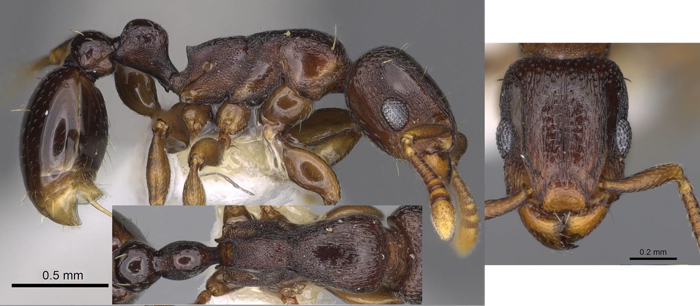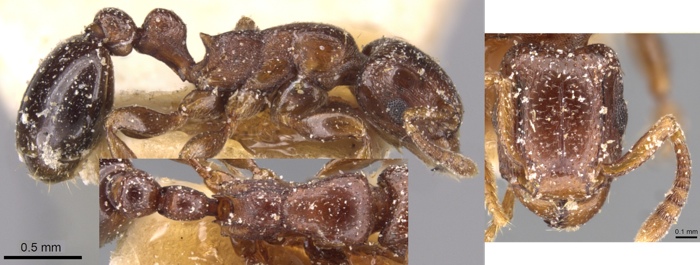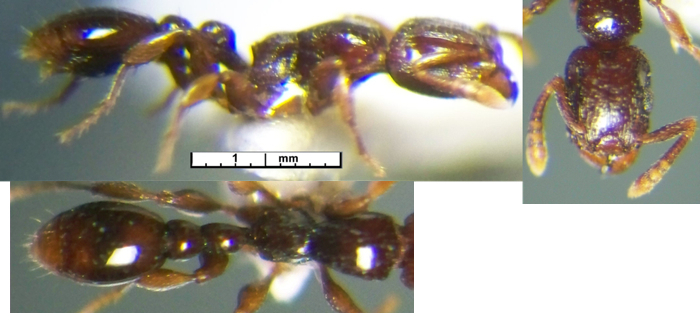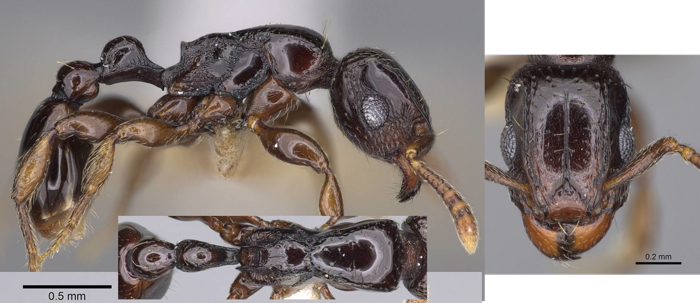SUBFAMILY MYRMICINAE - Genus Decamorium
| The Ants of
Africa SUBFAMILY MYRMICINAE - Genus Decamorium |
|
| Contents - Myrmicinae - MYRMICINAE Introduction |
In Tribe TETRAMORIINI.
Diagnostic Features - The key feature is the 10-segmented antenna, with a 3-segmented club.
|
Forel's (1913a) genus description is at Bolton (1976, 1995) listed only two species. Note: Hita Garcia & Fisher (2014) (see http://zookeys.pensoft.net/articles.php?id=3817) opine that Decamorium should be subsumed under Tetramorium, with Decamorium being a "species-group" |
| Key following Hita Garcia
& Fisher (2014) |
| 1 |
Dorsum of promesonotum with
conspicuous longitudinally rugose/rugulose sculpture |
2 |
| -- |
Dorsum of promesonotum
unsculptured, smooth, and usually very shiny |
3 |
| 2 |
 Slightly smaller species, TL ca 3.2 mm, (WL 0.88–0.93); HL 0.64-0.68, HW 0.53-0.56; propodeum armed
with shorter, triangular, and acute teeth (PSLI 10–11); dorsum of
promesonotum longitudinally rugulose with very little ground sculpture,
lateral pronotum mostly unsculptured and shiny, only dorsally
longitudinally rugulose; generally of uniform dark brown colour;
rainforest species Slightly smaller species, TL ca 3.2 mm, (WL 0.88–0.93); HL 0.64-0.68, HW 0.53-0.56; propodeum armed
with shorter, triangular, and acute teeth (PSLI 10–11); dorsum of
promesonotum longitudinally rugulose with very little ground sculpture,
lateral pronotum mostly unsculptured and shiny, only dorsally
longitudinally rugulose; generally of uniform dark brown colour;
rainforest species |
Cameroun,
Nigeria - raptor |
| -- |
 Slightly
larger species (WL 0.98–1.06); HL 0.67-0.72, HW 0.54-0.59; propodeum
armed
with longer, triangular to elongate-triangular, and acute teeth (PSLI
16–18); dorsum of promesonotum and lateral pronotum strongly
longitudinally rugose with
distinct punctate ground sculpture; strongly bicoloured species with
dark brown or black gaster contrasting with light brown to reddish
brown on
remainderof body; savannah species Slightly
larger species (WL 0.98–1.06); HL 0.67-0.72, HW 0.54-0.59; propodeum
armed
with longer, triangular to elongate-triangular, and acute teeth (PSLI
16–18); dorsum of promesonotum and lateral pronotum strongly
longitudinally rugose with
distinct punctate ground sculpture; strongly bicoloured species with
dark brown or black gaster contrasting with light brown to reddish
brown on
remainderof body; savannah species |
West
Africa & Congo Basin - uelense |
| 3 |
 Generally larger species (WL 1.02–1.16); HL 0.71-0.74, HW 0.59-0.62; propodeal teeth
relatively longer (PSLI 17–19); petiolar node in profile relatively higher, in profile
1.2 to 1.3 times higher than long (LPeI 77–82); strongly bicoloured species with
dark brown or black gaster contrasting with light brown to reddish brown
remainder of body Generally larger species (WL 1.02–1.16); HL 0.71-0.74, HW 0.59-0.62; propodeal teeth
relatively longer (PSLI 17–19); petiolar node in profile relatively higher, in profile
1.2 to 1.3 times higher than long (LPeI 77–82); strongly bicoloured species with
dark brown or black gaster contrasting with light brown to reddish brown
remainder of body |
Kenya,
Tanzania, Zimbabwe - decem |
| -- |
Generally smaller species (WL
0.85–0.98); propodeal teeth relatively shorter (PSLI 9–13); petiolar node relatively lower, in profile around 1.0 to
1.2 times higher than long (LPeI 86–100); usually of uniform brown colour, if
bicoloured, then only slightly so and never as well developed as above |
4 |
| 4 |
 Smaller eyes (OI 33–36); HL 0.62-0.70, HW 0.48-0.58; body
colouration uniformly light brown to chestnut brown Smaller eyes (OI 33–36); HL 0.62-0.70, HW 0.48-0.58; body
colouration uniformly light brown to chestnut brown |
Cameroun & East
Africa - ultor |
| -- |
 Larger eyes (OI 37–40); HL 0.64-0.71, HW 0.51-0.59; body
colouration uniformly dark brown to black, always darker than above. Larger eyes (OI 37–40); HL 0.64-0.71, HW 0.51-0.59; body
colouration uniformly dark brown to black, always darker than above. |
Liberia
east to Uganda - venator |
| MYRMICINAE Introduction |
© 2007, 2011, 2012, 2015 - Brian Taylor CBiol FSB FRES 11, Grazingfield, Wilford, Nottingham, NG11 7FN, U.K. |
href="decamorium.htm"